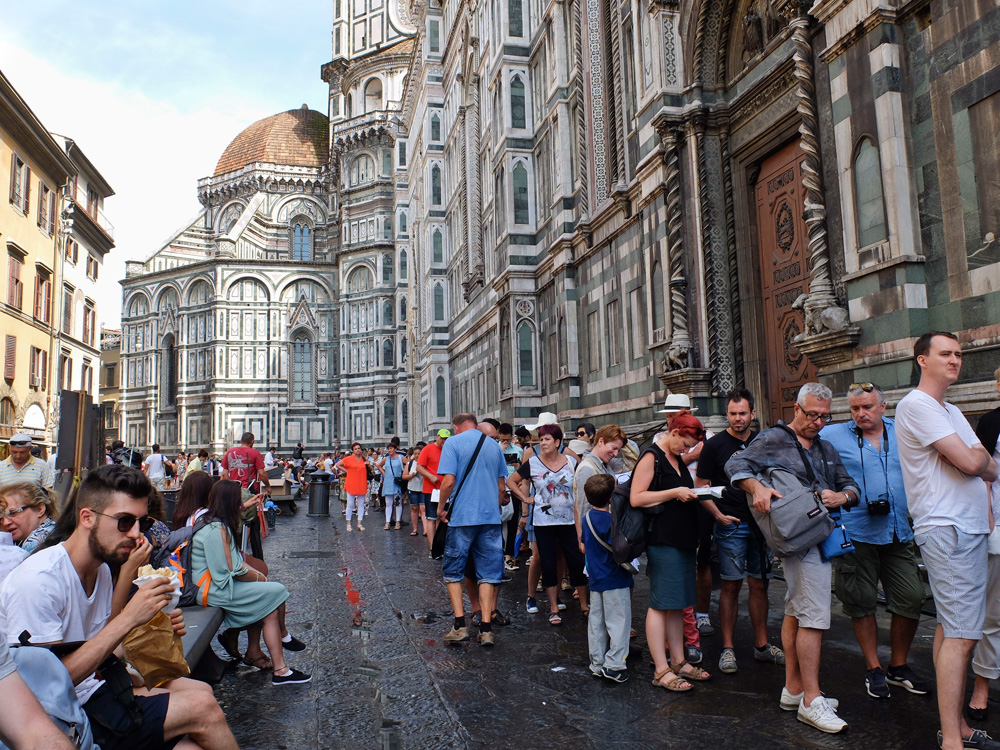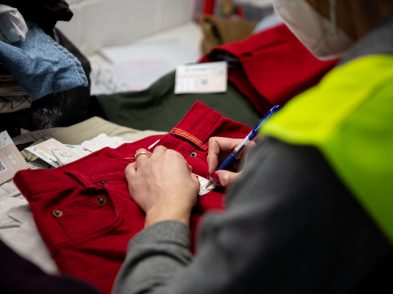People have been complaining about “the tourists” in Florence for at least a century, but crowds and their behaviour keep getting worse, not better. This year, city administrations are taking action. But is there any way to reverse the trend?
November may be rainy here, but it’s a fast walker’s paradise. The streets, devoid of tourists, take back their medieval aura, ringing with the sounds of neighbours exchanging greetings across time-worn windowsills and the clanking of the coffee machine and its cups at the local bar. This is the Florence I fell in love with, and I renew my vows with it each year.
Then Easter rolls around and the city once again plays host to millions of people. We huff and puff crossing piazza Duomo, dodge selfie sticks while attempting to reach a government office, and risk being run over by a bus while dipping into the road to pass slow trolley-pullers near the station. It’s not just the crowds: people seem to become more maleducati by the minute.

The summer of 2017 goes down in history as the moment it all came to a head, when cities like Venice, Rome, Dubrovnik and Barcelona said basta, imposing a series of mostly ineffective knee-jerk solutions. For every hungry visitor eating a panino on the steps of Santa Croce there’s a wet surprise; for every insane swimmer in the Grand Canal there’s a hefty fine. For dreamers wishing to return to Rome by tossing a coin into the Trevi Fountain, there’s a crowd-limiting path and a newly minted police officer urging them not to stick around.
Representatives of Italy’s five main art cities met in Rome in July 2017 to kick off a joint effort to come up with a solution to the tourist invasion problem. A first visible step is the launch of a communications campaign defined differently for each city―Venice was the first to launch #EnjoyRespectVenezia, with a corresponding plan of action and fines, closely followed by the work-in-progress campaign of #EnjoyRespectFirenze.
“Florence is a welcoming city,” says Anna Paola Concia, Florence’s superintendent of tourism “…but with rules. If I come into your house I have to play by your rules.” That’s why the city has issued a series of images illustrating stick figures lazing on church steps, buying illegal handbags and tossing trash on the streets, contrasted with images of the corresponding correct behaviour (benches, stores, bins). “We didn’t want to prohibit but to suggest actions,” explained Concia. But will an internet campaign and printed gadgets be enough to influence mass behaviour into a positive cycle?

Perhaps we need to look at the bigger picture. In search of a solution, I contacted Carlo Francini, head of the UNESCO office of the City of Florence and coordinator of a management plan for its historic center (approved January 2016). His office’s plan provides guidelines for a holistic approach to management of the territory and its tourism, the organisation of transport and commerce, and other aspects of the city’s cultural and social life. The involved entities (namely local government) have to follow this plan.
I asked both Francini and Concia if they were inspired by a best practice in place in another city. Neither were able to name one: there isn’t a city in the world that has figured it out yet. Both point out that every place is unique, and indeed, Florence has unique problems.
“Florence is a UNESCO World Heritage site,” Francini reminds me, “and as such it has to be accessible to all.” Only when visitors threaten the preservation of a monument, as is the case with the caves of Lascaux (where you can only enter a reproduction) is a UNESCO site closed to the public. This precludes the concept of limited access, to which Concia is also strongly opposed―who are we to decide who is allowed to experience Florence? So while the UNESCO management plan identifies five main threats to the city’s World Heritage and the impact of mass tourism is at the top of the list, even when tourism negatively impacts both residents and the visitor experience, accessibility takes priority.
Tourism will continue to grow (the World Tourism Organization shows four percent annual growth), but both Concia and Francini seem optimistic about replacing mass with quality. A series of projects in the management plan are already in action, such as using Firenzecard to encourage visiting minor museums, rendering the Uffizi more efficient (director Eike Schmidt’s dream) and decentralizing visitors towards the Oltrarno through initiatives like the new combined Uffizi-Pitti tickets or the (temporary) bus up the hill to Forte Belvedere.
Better signage, services and transportation have been advised to help alleviate the flow in crunch areas, while storytelling about the many things to discover outside the Duomo-Uffizi express lane might encourage longer or more meaningful stays. Amongst these, Francini sees the Medici villas (recently added to the UNESCO list) as a great opportunity for development. Another opportunity is the low season: Schmidt recently declared that he hoped visitors from neighbouring European countries would choose to come to Florence during the four months in which his museum’s tickets cost 50 percent less. My sacrosanct off-season.
If all good plans are followed, will Florence be able to reverse the trend? Superintendent Concia is asking everyone, visitors and residents, to participate in making Florence welcoming, and I think that’s the key to the riddle. But what does welcoming mean exactly? To me, it means making the right decisions based on our civic pride. All of us, together. One of the reasons that Florence is listed as a UNESCO Heritage Site is for its role in the development of Humanism, and in particular for the brand of Civic Humanism of which Leonardo Bruni is the prime exponent. Clutching his proud history of Florence in his Santa Croce tomb, Bruni is looking over at us and saying, “If every one of you were to think about the greater good, there’d be only artisan products, local foods, clean streets, electric car sharing, happy foreign visitors and civil discussions of everything from politics to culture and religion.” It’s a long road, with plenty of litter to pick up along the way. And, to mix my historical metaphors, most likely an impossible Utopia.







